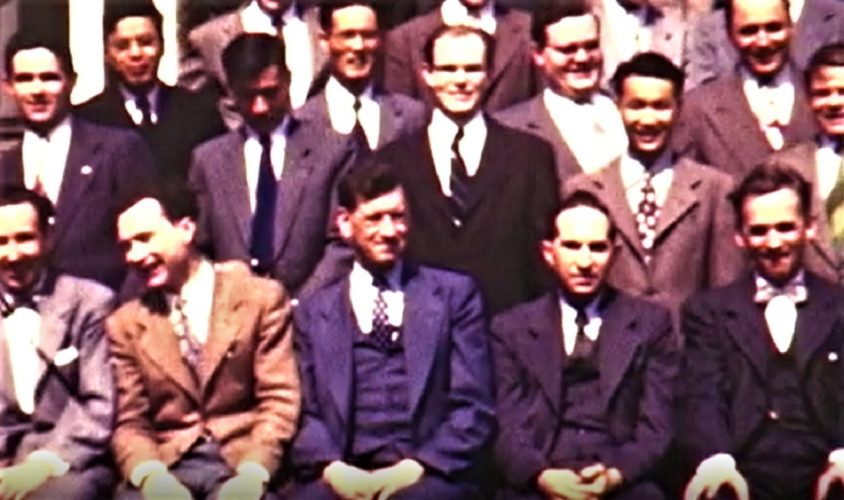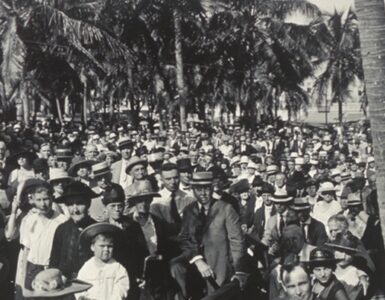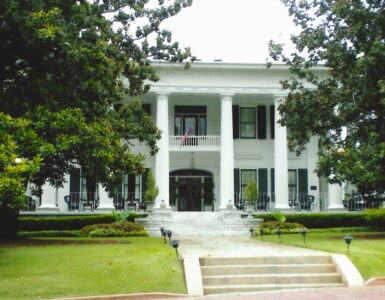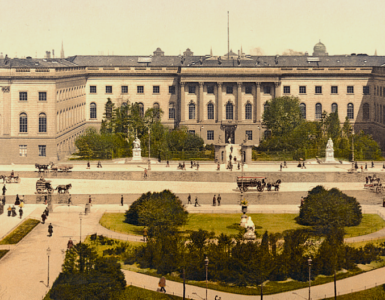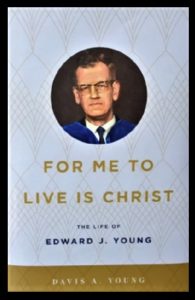 It was common in the nineteenth century for family members to write biographies of their deceased kin. For example, The Life of Archibald Alexander, 1856, was edited by his eldest son J. W. Alexander; the Life of Charles Hodge, 1880, was compiled by his Princetonian heir A. A. Hodge; Thornwell Jacobs, president of Oglethorpe University, wrote about his father in The Life of William Plumer Jacobs, 1918; and Peyton H. Hoge authored a volume about his uncle’s pastorate in Moses Drury Hoge: Life and Letters, 1899. A strength of any of these works is the writer had access to private papers, correspondence, journals, and personal remembrances as well as recollections from surviving family members. Davis A. Young in For Me to Live is Christ: The Life of Edward J. Young provides a similar type of biography of his father. The book is published by the Committee for the Historian of the Orthodox Presbyterian Church (OPC), and it gives a detailed sympathetic biography of Edward Joseph (Joe) Young. The author is Professor Emeritus of Geology at Calvin University having taught there and at other universities for over forty years. As for the book itself, the clothbound volume’s text block is made up of Smyth-sewn signatures of quality buff paper, bound with blue cloth boards, and wrapped with a gloss-finish dustjacket bearing a portrait of Young.
It was common in the nineteenth century for family members to write biographies of their deceased kin. For example, The Life of Archibald Alexander, 1856, was edited by his eldest son J. W. Alexander; the Life of Charles Hodge, 1880, was compiled by his Princetonian heir A. A. Hodge; Thornwell Jacobs, president of Oglethorpe University, wrote about his father in The Life of William Plumer Jacobs, 1918; and Peyton H. Hoge authored a volume about his uncle’s pastorate in Moses Drury Hoge: Life and Letters, 1899. A strength of any of these works is the writer had access to private papers, correspondence, journals, and personal remembrances as well as recollections from surviving family members. Davis A. Young in For Me to Live is Christ: The Life of Edward J. Young provides a similar type of biography of his father. The book is published by the Committee for the Historian of the Orthodox Presbyterian Church (OPC), and it gives a detailed sympathetic biography of Edward Joseph (Joe) Young. The author is Professor Emeritus of Geology at Calvin University having taught there and at other universities for over forty years. As for the book itself, the clothbound volume’s text block is made up of Smyth-sewn signatures of quality buff paper, bound with blue cloth boards, and wrapped with a gloss-finish dustjacket bearing a portrait of Young.
Edward J. Young was born November 29, 1907 in San Francisco only a year after the great earthquake destroyed the city. He reluctantly began theological studies at San Francisco Theological Seminary in San Anselmo but then chose to complete his degree at Westminster Theological Seminary in Philadelphia. His studies and gifts for teaching led to his appointment for the 1936-1937 academic year assisting Alan MacRae in Old Testament studies. During the spring semester MacRae resigned from Westminster over issues recounted in the book on page 98. Young was left to teach Old Testament with full professorship granted in 1946 with his inaugural lecture titled, “The Authorship of Isaiah 40-66.” The book of Isaiah would constitute a great portion of his life’s work yielding a three-volume commentary, The Book of Isaiah: The English Text, With Introduction, Exposition, and Notes, 1965-1972. The last two volumes were issued posthumously from Young’s manuscripts. Young was a man of exceptional linguistic ability mastering over twenty languages not only with a reading knowledge but in some cases conversational as well. Dr. Young worked diligently teaching, writing, speaking in churches and conferences, and as a churchman traveling for ministry until Valentine’s Day in 1968 when he died from a massive heart attack. His death is recounted in chapter 31 which includes a poignant remembrance by his widow, Lilian, pages 324-25.
An advantage of Davis Young’s book is that the personal side is included with the professional. For example, Young enjoyed watching on television Alfred Hitchcock movies, Perry Mason, and Star Trek. The author mentions going to see Hitchcock’s Vertigo with his father at the movie theater. For Young’s analytical mind Hitchcock’s use of suspense and attention to details developing a plot would have been attractive, as would Perry Mason hunting down evidence and legal precedents to make a case that would stand up in court and vindicate his client. Why Star Trek? Possibly, the draw was escapism as he tabled the day’s labors and boldly went where no man had gone before. Young appears to have liked cars and became partial to Chevrolets until a second car was needed for Lilian, a 1964 Volkswagen. He travelled often not only supplying pulpits locally, teaching in both Evangelical and Reformed Bible conferences, and fulfilling church responsibilities, but he also travelled as far as Japan and the Middle East. One aspect of Young’s character brought out by his son was his ability to get along with those who differed with him theologically, he still disagreed with them, but he could do so amicably. One example of this is the British higher critic H. H. Rowley, with whom he corresponded and exchanged publications. Rowley said of Young, he
always treats the views of those with whom he disagrees with respect and courtesy, and there is never any bitterness of tone even when he is most uncompromising. (p. 176)
Even though Young could get along with different views, it seems he really struggled with those views when editing a commentary series or single publication with multiple authors. His convictions about the authenticity and infallibility of the Bible, Mosaic authorship of the Pentateuch, and that Isaiah was written by a single prophet combined with his commitment to the Westminster Standards greatly reduced the field of potential writers. He was concerned about how neoorthodox thinking was infiltrating the church and how it redefined orthodox terminology was deceptive and dangerous. It is one thing to get along with those who differ in academic debates, but it is quite another to give them stamps of approval by using their articles presenting their views in a publication one is editing. If there is only one point to be taken away from For Me to Live is Christ it is that E. J. Young had a strong sense of the responsibility of his calling to make sure the saints were always given the truth by which they were to be sanctified.
Young was innovative regarding his method for teaching Hebrew and was concerned that seminaries should not abandon in-depth education in the biblical languages. In 1960, he published Old Testament Hebrew for Beginners, which applied his method for teaching that used English character transliterations of Hebrew Bible text before students read the actual text in Hebrew. He believed the transliterations simplified learning the language. The students learned Hebrew by this method for one year and then transitioned to reading the text with Hebrew characters. It seems that this method would be more complex than simply reading the Hebrew of the Bible from day one, but could there have been another benefit to using his method? In the header image there are three or four graduates that appear to be of Asian nationality and were likely foreign students intending to return to their homelands for ministry. Whether Japanese, Korean, or Chinese these students would have had some facility with English as their second language or they would not have been able to graduate. When they studied Hebrew in seminary classes they were translating Hebrew into English through their first language; those whose first language was English had a leg up because their first language and the translated text language were the same. The use of transliterations provided a familiar alphabet for the foreign students to read Hebrew before reading the actual biblical text. The author points out that Dr. Young had considerable interest in the foreign missions work of the OPC and his transliteration method may have envisioned students from all over the world coming to the United States for theological education. Thus, a benefit, possibly, of Young’s transliteration method might have been easing the load of foreign students that are already challenged by having English as a second language. Another aspect of his method was the text used for his beginning classes was Exodus 3. The faculty that followed E. J. Young continued to use Exodus 3 for beginning Hebrew, but they abandoned the transitional transliteration phase opting to get into the Hebrew directly.
I recommend For Me to Live is Christ to those interested in the life of E. J. Young, debates concerning the doctrine of Scripture, OPC history, Presbyterian history, and the history of Westminster Seminary. Young’s view of the days of creation is explained by the author and he discusses his father’s considerable work in Genesis that was destined for a commentary he was unable to complete. Some other books published by Young are An Introduction to the Old Testament, My Servants the Prophets, and Thy Word is Truth. Davis Young has written a biography of his father that paints a more complete picture of the man and his work, much as those admiring kin of the nineteenth century told the stories of their relatives.
Barry Waugh
Notes—The copy of the book used for this review was purchased by the reviewer. Biographies of some individuals mentioned in the first paragraph of this article are available on Presbyterians of the Past including: J. W. Alexander, A. A. Hodge, Moses D. Hoge, and William P. Jacobs. I am sorry for the quality of the header, but it shows a section of a frame from a deteriorating celluloid home movie made in 1950 kindly provided by the Meiners family. Harry Meiners graduated that year and two of his children were baptized by E. J. Young who is seated on the front row wearing a blue suit with John Murray to his left. The book is available from the Orthodox Presbyterian Church for 10.00 plus shipping; yes, that is the real price.


